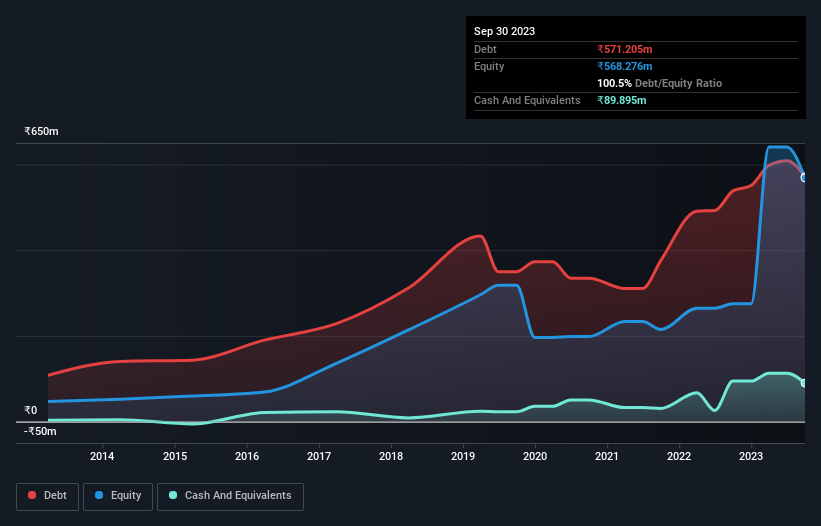Jet Freight Logistics (NSE:JETFREIGHT) Use Of Debt Could Be Considered Risky

Legendary fund manager Li Lu (who Charlie Munger backed) once said, 'The biggest investment risk is not the volatility of prices, but whether you will suffer a permanent loss of capital.' When we think about how risky a company is, we always like to look at its use of debt, since debt overload can lead to ruin. We can see that Jet Freight Logistics Limited (NSE:JETFREIGHT) does use debt in its business. But should shareholders be worried about its use of debt?
Why Does Debt Bring Risk?
Debt is a tool to help businesses grow, but if a business is incapable of paying off its lenders, then it exists at their mercy. Ultimately, if the company can't fulfill its legal obligations to repay debt, shareholders could walk away with nothing. While that is not too common, we often do see indebted companies permanently diluting shareholders because lenders force them to raise capital at a distressed price. Of course, debt can be an important tool in businesses, particularly capital heavy businesses. When we think about a company's use of debt, we first look at cash and debt together.
See our latest analysis for Jet Freight Logistics
What Is Jet Freight Logistics's Debt?
The image below, which you can click on for greater detail, shows that at September 2023 Jet Freight Logistics had debt of ₹571.2m, up from ₹538.3m in one year. However, it does have ₹89.9m in cash offsetting this, leading to net debt of about ₹481.3m.

How Healthy Is Jet Freight Logistics' Balance Sheet?
We can see from the most recent balance sheet that Jet Freight Logistics had liabilities of ₹811.5m falling due within a year, and liabilities of ₹185.7m due beyond that. On the other hand, it had cash of ₹89.9m and ₹495.2m worth of receivables due within a year. So its liabilities outweigh the sum of its cash and (near-term) receivables by ₹412.1m.
While this might seem like a lot, it is not so bad since Jet Freight Logistics has a market capitalization of ₹751.7m, and so it could probably strengthen its balance sheet by raising capital if it needed to. However, it is still worthwhile taking a close look at its ability to pay off debt.
We use two main ratios to inform us about debt levels relative to earnings. The first is net debt divided by earnings before interest, tax, depreciation, and amortization (EBITDA), while the second is how many times its earnings before interest and tax (EBIT) covers its interest expense (or its interest cover, for short). The advantage of this approach is that we take into account both the absolute quantum of debt (with net debt to EBITDA) and the actual interest expenses associated with that debt (with its interest cover ratio).
Jet Freight Logistics shareholders face the double whammy of a high net debt to EBITDA ratio (18.9), and fairly weak interest coverage, since EBIT is just 0.077 times the interest expense. This means we'd consider it to have a heavy debt load. Worse, Jet Freight Logistics's EBIT was down 95% over the last year. If earnings continue to follow that trajectory, paying off that debt load will be harder than convincing us to run a marathon in the rain. When analysing debt levels, the balance sheet is the obvious place to start. But it is Jet Freight Logistics's earnings that will influence how the balance sheet holds up in the future. So if you're keen to discover more about its earnings, it might be worth checking out this graph of its long term earnings trend.
But our final consideration is also important, because a company cannot pay debt with paper profits; it needs cold hard cash. So we clearly need to look at whether that EBIT is leading to corresponding free cash flow. During the last three years, Jet Freight Logistics burned a lot of cash. While investors are no doubt expecting a reversal of that situation in due course, it clearly does mean its use of debt is more risky.
Our View
To be frank both Jet Freight Logistics's conversion of EBIT to free cash flow and its track record of (not) growing its EBIT make us rather uncomfortable with its debt levels. But at least its level of total liabilities is not so bad. Taking into account all the aforementioned factors, it looks like Jet Freight Logistics has too much debt. That sort of riskiness is ok for some, but it certainly doesn't float our boat. The balance sheet is clearly the area to focus on when you are analysing debt. However, not all investment risk resides within the balance sheet - far from it. For instance, we've identified 5 warning signs for Jet Freight Logistics that you should be aware of.
At the end of the day, it's often better to focus on companies that are free from net debt. You can access our special list of such companies (all with a track record of profit growth). It's free.
New: Manage All Your Stock Portfolios in One Place
We've created the ultimate portfolio companion for stock investors, and it's free.
• Connect an unlimited number of Portfolios and see your total in one currency
• Be alerted to new Warning Signs or Risks via email or mobile
• Track the Fair Value of your stocks
Have feedback on this article? Concerned about the content? Get in touch with us directly. Alternatively, email editorial-team (at) simplywallst.com.
This article by Simply Wall St is general in nature. We provide commentary based on historical data and analyst forecasts only using an unbiased methodology and our articles are not intended to be financial advice. It does not constitute a recommendation to buy or sell any stock, and does not take account of your objectives, or your financial situation. We aim to bring you long-term focused analysis driven by fundamental data. Note that our analysis may not factor in the latest price-sensitive company announcements or qualitative material. Simply Wall St has no position in any stocks mentioned.
About NSEI:JETFREIGHT
Jet Freight Logistics
Engages in the freight forwarding business in India.
Good value with acceptable track record.
Market Insights
Community Narratives



